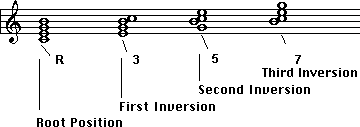
If you stack a third on top of a triad you get a seventh chord. The chord gets its name from the interval of a seventh formed between the root and the bass.

The names of the chord notes are root, third, fifth, and seventh.

It can be confusing at first whether to call a chord a "seventh" chord or a "seven" chord. The term seventh refers to a class of chords as in "Seventh chords are more common in Romantic period music than in Classical period music." The term seven refers to an individual chord as in "that's a G Seven chord."
There are nine seventh chord qualities. Eight of them are formed from the combination of the four triad qualities plus a major or minor seventh. The ninth quality is the fully diminished seven chord that is formed from a diminished triad and the interval of a diminished seventh.





The general form of a seventh chord name is
<ROOT><TRIAD QUALITY> <SEVENTH QUALITY>
An example would be an Eb Major Minor 7 chord. The first term (Eb) refers to the root of the chord. The second term (Major) refers to the quality of the triad that forms the lower three notes of the seventh chord. The third term (Minor) refers to the quality of the interval of the seventh formed between the root and the seventh. You can abbreviate the names by using upper case M for major and lower case m for minor, Eb Mm7.
Seventh Chord Quality |
Notation |
Long Name |
Short Name |
Listen |
| Major Major | F Major
Major 7 |
FMM7 FM7 FMaj7 F Major 7 |
||
| Major Minor | F Major
Minor 7 |
FMm7 F7 |
||
| Minor Major | F Minor
Major 7 |
FmM7 |
||
| Minor Minor | F Minor
Minor 7 |
Fmm7 Fm7 Fmin7 F minor 7 |
||
| Diminished Major | F Diminished
Major 7 |
FdM7
|
||
| Diminished Minor | F Diminished
Minor 7, F Half Diminished 7 |
F°m7 Fø7 Fm7b5 |
||
| Diminished | F Diminished
7 |
F°7 Fdim7 |
||
| Augmented Major | F Augmented
Major 7 |
F+M7 FM7#5 |
||
| Augmented Minor | F Augmented
Minor 7 |
F+7 F7#5 |
Five seventh chords are commonly used:
• MM7 (Major Major 7)
• 7 (Major Minor 7)
• m7 (Minor Minor 7)
• ø7 (Diminished Minor 7, half diminished 7)
• °7 (Diminished Diminished 7)

A seventh chord can appear in four inversions depending on whether the root, third, fifth, or seventh is the lowest note. In the following example, the CMM7 chord appears in four different inversions.

The dominant seven chord is the most commonly used seventh chord. In scale degree terms the fifth note of the scale is called the dominant. The seventh chord that is built on the fifth note of the scale is called the dominant seven chord, or the V7 ("five seven") chord.

The naming conventions for seventh chords also apply to Roman Numerals.
The scale degree of the root is expressed as a Roman Numeral, e.g.: I, ii, iii, iv V
These are commonly used abbreviations for seventh chord qualities.
Quality |
Chord Type | Example |
M7 |
Major Major 7 | IM7and IVM7 |
7 |
Major minor 7 | V7 |
m7 |
Minor Minor 7 | ii7 iii7 vi7 |
ø7 or 7b5 |
Half Diminished 7 | iiø7 or ii7b5 |
°7 |
Fully Diminished 7 | vii°7 |
mM7 |
Minor Major 7 | imM7 |
7#5 or +7 |
Augmented Minor 7 | III+7 or III7#5 |
M7#5 or +M7 |
Augmented Major 7 | IIIM7#5 |

The symbols used to identify seventh chord inversions are based on the interval structure measured upwards from the lowest note of the inversion in closed spacing.

This example is in C Major and is true for every major scale.

This example is in C natural minor and is true for every natural minor scale.

This example is in C harmonic minor and is true for every harmonic minor scale.

This example is in C melodic minor and is true for every melodic minor scale.

Question: Name this chord in the key of D Major.

1. Key (It's D Major - the directions said so)
2. Root (it's E)

3. Quality (It's minor minor 7)

4. Inversion (It's 65, because that's the symbol for a first inversion seventh chord)

5. Roman Numeral Root (It's ii because E is the second note in the scale of D major)
6. Answer: ii65
Question: Write (or Play) a iiø43 chord in the key of G minor.
1. Key (It's g minor - the directions said so)
2. Root Scale Degree (It's A because A is the second (ii) note of the G minor scale)

3. Quality (It's half diminished 7 because of the ø)

4. Inversion (It's a second inversion seventh chord because of the 43)

5. Answer:

Revised by John Ellinger, Spring 2012.